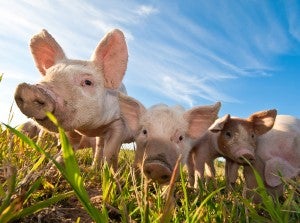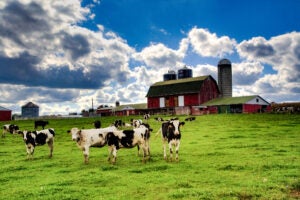“Despite all our accomplishments, we all owe our existence to a six-inch layer of topsoil and the fact it rains,” said Paul Harvey. And, he wasn’t wrong.
Farmers have a distinct understanding of nature’s influence. Excessive or insufficient rainfall can devastate a harvest. Imbalances in soil nutrients can cause crops to fall or yield poorly. Factors like temperature, wind, rain, frost, and snow shape how farmers care for their crops and animals.
We hold nature in high regard, appreciating its fluctuations. We understand our reliance on the natural resources we are surrounded by. Therefore, Earth Day today serves not only as a reminder of our duty to the environment but also an acknowledgment of the daily efforts farmers make to show their reverence for Mother Nature.
Demonstrating commitment with on-farm data
The recognition of our dependence on that six-inches of top soil means we also recognize the value of data that helps farmers make informed decisions to care for people, pigs and the planet.
The National Pork Board, National Dairy Farmers Assuring Responsible Management, and the National Milk Producers Federation have offered data and resources on Earth Day.
Pork Cares snapshot
Farm-level data from the recently released 2022 Pork Cares Snapshot Report highlights the continued progress of America’s pig farmers in terms of sustainability and stewardship on the farm. The data represents information from more than 300 Pork Cares Farm Impact Reports completed by U.S. pig farmers.
As shared by National Pork Board Chief Sustainability Officer, Jamie Burr, one of the most significant results from the 2022 Pork Cares Snapshot Report is the industry’s emerging role as a carbon sink.
With a net greenhouse gas emissions figure of -0.44 tons CO₂ equivalent per acre and 0.28 tons of carbon sequestered per acre, pork producers remove more carbon from the atmosphere than they produce. Agriculture and forestry represent the only two industry sectors that can sequester carbon — another unique way our industry can offer partnerships to organizations with sustainability goals.
“Like most farmers, we’re aiming for progress, not perfection. And like most farmers, we’re always working to learn more about how to continue on the path of progress,” says Bill Even, chief executive officer of the National Pork Board. “Our family’s farm represents the thousands of U.S. farmers who daily balance doing what’s best for their animals, crops, communities, and planet.”

Dairy celebrates progress with the Conservation Practice Questionnaire
“Dairy farmers have long been early adopters of sustainable practices and good stewards of the land,” Nicole Ayache, NMPF’s chief sustainability officer, said. “The findings from our Conservation Practice Questionnaire underscore the U.S. dairy industry’s commitment to continuous improvement and finding new ways to be even more sustainable.”
The questionnaire, a voluntary addition to the FARM Environmental Stewardship Program, highlights some of U.S. dairy farmers’ conservation efforts, including practices and technologies that show effective water, energy and other resource stewardship.
FARM ES launched the questionnaire in August 2022 after significant stakeholder feedback and on-farm piloting. More than 450 of them have been completed on dairy farms across 20 states since its launch, with respondents ranging in milking herd size from 17 cows to more than 15,000. The completed questionnaires offer a lens into the natural resource stewardship of the dairy farmers who participate.

As of March 2024, questionnaires indicate that:
- 79% of participating dairy farmers reuse or recycle water on their farm: 76% reuse plate cooler water to flush the barn, as drinking water, or for other uses, 14% capture rainwater for cleaning or other uses, and 29% reuse water for irrigation
- 90% of participating farms report implementing field conservation practices
- 68% of participating farmers use recycled manure, recycled sand, or byproducts as bedding for their cows
- More than 97% of participating dairy farmers use energy-saving technologies and practices
To further support dairy farmers efforts to implement conservation practices and technologies, the FARM Program launched a searchable database of technical and financial resources. Farmers and their technical advisers may use the new resource to identify support suitable to the farm’s conservation goals.
The database contains information from government, non-profit, extension, state planning tools, and many other relevant financial or technical assistance providers and resources. Financial resources include grants, cost-share, loan programs and other incentives available. The database’s first focus areas are resources for cover cropping, conservation tillage, energy efficiency, nutrient management, and pollinator habitat.


